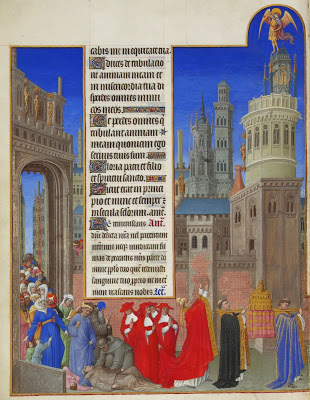

| Online: | |
| Visits: | |
| Stories: |

| Story Views | |
| Now: | |
| Last Hour: | |
| Last 24 Hours: | |
| Total: | |
How Medieval Christians Celebrated the Rogation Days (with a Dragon)
“Mindful of that promise of the Gospel, ‘Ask, and ye shall receive,’ (John 16, 24; from the Gospel of the Sunday which precedes the Lesser Litanies) St Mamertus, bishop of Vienne, in this week instituted the three days of the Litanies, because of an urgent necessity … days which are greatly celebrated by every church with fasts and prayers. The Greek word ‘litany’ means ‘supplication,’ because in the Litanies we beseech the Lord that he may defend us from every adversity, and sudden death; and we pray the Saints that they may intercede for us before the Lord. … The Church celebrates the Litanies with devotion in these three days, with (processional) crosses, banners, and relics She goes from church to church, humbly praying the Saints that they may intercede with God for our excesses, ‘that we may obtain by their intercession what we cannot obtain by our own merits.’ (citing a commonly used votive Collect of all the Saints.) …
It is the custom of certain churches also to carry a dragon on the first two days before the Cross and banner, with a long, inflated tail, but on the third day, (it goes) behind the Cross and banners, with its tail down. This is the devil, who in three periods, before the Law, under the Law, and under grace, deceives us, or wishes to do so. In the first two (periods) he was, as it were, the lord of the world; therefore, he is called the Prince or God of this world, and for this reason, in the first day, he goes with his tail inflated. In the time of grace, however, he was conquered by Christ, nor dares he to reign openly, but seduces men in a hidden way; this is the reason why on the last day he follows with his tail down.” (Ordo Officiorum Ecclesiae Senensis, 222)
Oderico does not describe the dragon, but given that Siena is in Tuscany, still a major center of leather-working to this day, we may imagine that the dragon itself was a large wooden image mounted on wheels or a cart, and the inflatable tail something like a leather bellows. It should be noted that in addition to the processional cross, Oderico mentions both banners and relics as part of the processional apparatus. In the medieval period, it was considered particularly important to carry relics in procession; so much so that, for example, a rubric of the Sarum Missal prescribes that a bier with relics in it be carried even in the Palm Sunday procession. A typical bier for these processions is shown in the lower right corner of this page of the famous Book of Hours known as the Très Riches Heures du duc de Berry. made by the Limbourg brothers between 1411 and 1416.
Source: http://www.newliturgicalmovement.org/2016/05/how-medieval-christians-celebrated.html



